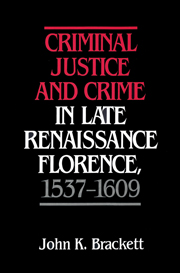Book contents
- Frontmatter
- Contents
- Acknowledgments
- Introduction
- 1 The bureaucratic structure of the Otto: the personnel and their functions
- 2 Financing the Otto
- 3 The Otto as police: organization and function
- 4 Criminal procedure before the Otto: from discovery to sentencing
- 5 The Otto and its role in the centralization of criminal justice in the Florentine state
- 6 Crime and criminals
- Conclusion
- Appendix 1 Names of other officers of the Otto di Guardia e Balìa, 1537–1609, as we have them
- Appendix 2 Budget totals by year
- Appendix 3 Comparison of detailed average expenditures for budgets, 1537–1547 and 1598–1609
- Appendix 4 Occupation key
- Bibliography
- Index
1 - The bureaucratic structure of the Otto: the personnel and their functions
Published online by Cambridge University Press: 05 September 2009
- Frontmatter
- Contents
- Acknowledgments
- Introduction
- 1 The bureaucratic structure of the Otto: the personnel and their functions
- 2 Financing the Otto
- 3 The Otto as police: organization and function
- 4 Criminal procedure before the Otto: from discovery to sentencing
- 5 The Otto and its role in the centralization of criminal justice in the Florentine state
- 6 Crime and criminals
- Conclusion
- Appendix 1 Names of other officers of the Otto di Guardia e Balìa, 1537–1609, as we have them
- Appendix 2 Budget totals by year
- Appendix 3 Comparison of detailed average expenditures for budgets, 1537–1547 and 1598–1609
- Appendix 4 Occupation key
- Bibliography
- Index
Summary
The Otto's rise to prominence as Florence's chief criminal magistracy, with wide jurisdictional competence in the city itself and its subject territories, did not occur immediately at its founding in 1378. Instead, its original mission was to conduct surveillance. A factional battle, known as the Ciompi Revolt, was then being waged for the control of the government by elements of the oligarchy, small shopkeepers, and clothworkers who were not represented by a guild. Created on 2 September 1378, the Otto di Guardia began as an ad hoc executive committee with extraordinary powers. The merchant-diarist Goro Dati explains its original duties:
The office of the Eight on Public Safety must stay alert and attentive to those who might try to do, or do, anything against the regime, and against the city, or castles or property of the commune. They have no authority to punish, but put the guilty into the hands of the rector, who then makes justice.
It is clear, then, that the Eight began as a political police during an extremely turbulent moment in Florentine political history. Reflecting the movement toward the equalization of political power that occurred just after the revolt (and that ended in 1382 with the oligarchical restoration), appointment to the office was equally divided between the seven major and the fourteen minor guilds. Its elected members reported the results of their investigations to the Signoria (the highest executive authority of government) in secret.
- Type
- Chapter
- Information
- Publisher: Cambridge University PressPrint publication year: 1992



